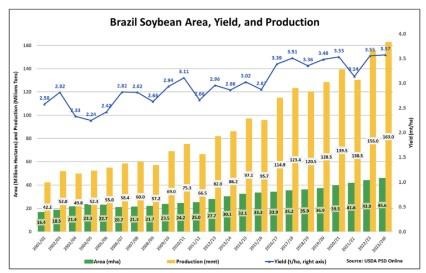By Carl Zulauf
Department of Agricultural, Environmental and Development Economics
Ohio State University
By Gary Schnitkey
Department of Agricultural and Consumer Economics
University of Illinois
The analysis discussed in the April 5 farmdoc daily found that payments to farmers by programs other than commodity programs and crop insurance have been countercyclical to US net cash income. This finding prompted a question, “Are crop insurance indemnities net of farm-paid premiums and commodity program payments countercyclical to net return to production?” This analysis finds that net crop insurance indemnities are not countercyclical to net return. Commodity program payments are, however, countercyclical, consistent with a common description of them. Crop insurance thus performs a different function at the US level than other farm safety net programs. In particular, the US crop insurance program not only helps cover yield loss in years of low net return but allows farms with a yield loss to more fully participate in years of high net return. The latter feature of crop insurance is seldom mentioned.
Data and Methods
Crops in this study are barley, corn, cotton, oats, peanuts, rice, sorghum, soybeans, and wheat. Each had a crop insurance contract throughout the 2002-2020 study period. This period follows the Agricultural Risk Protection Act of 2000. It authorized numerous changes to crop insurance, including higher premium subsidies. Crop insurance indemnities and farm-paid premiums are derived from the USDA, RMA (US Department of Agriculture, Risk Management Agency) Summary of Business. Farm-paid premiums are subtracted from indemnities to calculate net indemnities paid to farms by crop insurance.
Commodity payments are available at the US level by crop year, crop, and program for the 2002-2020 crop years, which determines the ending date of the study period. A list of sources for commodity program payments are in a Journal of the American Society of Farm Managers and Rural Appraisers (ASFMRA) article by Zulauf, Langemeier, and Schnitkey (2020). Commodity program payments are from programs authorized in Title 1 of the Farm Bill. They do not include ad hoc payments.
For each of the nine crops, USDA, ERS (Economic Research Service) calculates economic cost of production and net return per planted acre. All inputs except management are assigned a cost. Land, including farmer-owned land, and unpaid labor are assigned an opportunity cost. Quantity of inputs is based on periodic surveys of farms. Input prices are updated annually using prices collected by NASS (National Agricultural Statistics Service). Net return is calculated using yield per planted acre and a harvest month price. It is a private market return to management and risk at harvest. It does not include government program payments (commodity, crop insurance, ad hoc, conservation, livestock, etc.), farm-paid crop insurance premiums, and storage returns and costs.
An important assumption is that the USDA, ERS data accurately measures the cost and thus net return to produce a crop in the US. The authors think this assumption is reasonable but encourage readers to examine the discussion in the ASFMRA article and form their own opinion.
For each crop and year, economic cost per planted acre and net return per planted acre is multiplied by US acres planted to the crop for the year. Planted acres are from USDA, NASS QuickStats. Total US economic cost and total US net return for each crop for a year were summed to obtain US economic cost and net return for the nine crops as a group for that year.
Three ratios are calculated for each crop year for each crop and the nine crops collectively. One is US net crop insurance indemnities relative to US total cost of production. The second is US commodity program payments relative to US total cost of production. The third is US net return relative to US total cost of production.
Correlation with Net Return
For the nine crops as a group, the ratio of net indemnities to total cost of production had a correlation of +0.48 with the ratio of net return to total cost (see Figure 1). It differs from zero with 96% statistical confidence. A positive sign means that, for the nine crops as a group, net indemnities were highest (lowest) when net return to production were highest (lowest). Net indemnities thus were not countercyclical to net return for the nine crops as a group at the US level. Moreover, the statistical test suggests for the nine crops as a group at the US level net indemnities are likely pro-cyclical with net return.

In comparison, for the nine crops as a group, the ratio of commodity program payments to total cost had a correlation of -0.48 with the ratio of net return to total cost (see Figure 1). It differs from zero with 96% statistical confidence. The negative sign means commodity program payments were highest (lowest) when net returns were lowest (highest). Thus, consistent with the usual description, commodity payments were countercyclical to net return for the nine crops as a group at the US level.
The two correlations differ from each other with 99% statistical confidence. This finding implies that payments by the two farm safety net programs have a different relationship with US net return to production for the nine crops as a group and thus likely have different policy functions. However, it is also important to note that explanatory power of both relationships is 23% (0.48 squared). Thus, other variables are needed to explain most of the relationship.
To further examine the relationship between net indemnities and net return to production, correlations are calculated for each individual crop. They vary from -0.56 for peanuts to +0.42 for corn, but average -0.01 (see Figure 2). Moreover, only one correlation (peanuts with 98% statistical confidence)) differs statistically from zero at the 95% statistical confidence benchmark often used to conclude that a correlation differs from zero. In other words, except for peanuts, these correlations do not differ statistically from zero. In addition, from statistical testing theory, it is not unexpected that one or two of nine correlations would differ statistically from zero if the relationship is random. In summary, the weight of the collective evidence from the correlation analysis for the individual crops suggests crop insurance net indemnities likely have no relationship with net return to production at the US level and thus are not countercyclical to net return to production.

An individual crop analysis is not conducted for commodity programs because many commodity program payments since 2002, including those by the Agriculture Risk Coverage Program (ARC) and Price Loss Coverage (PLC), are paid on historical base (not planted) acres. Farmers can also plant or not plant any crop and still receive the base acre payment, with a few, limited exceptions. However, almost all base acres are planted to some crop, with most planted to at least one of the cost of production crops (Zulauf, Langemeier, and Schnitkey). A commodity program payment to one of the cost of production crops is thus likely made to an acre planted to a cost of production crop even if it was not planted to the cost of production crop receiving the payment. Therefore, the aggregate analysis for commodity program payments discussed above should be valid.
Discussion
Net farm crop insurance indemnities are found to not be countercyclical to net return at the US level for the nine large acreage field crops examined in this article. Moreover, net indemnities to the nine crops as a group at the US level may be pro-cyclical with net return. In contrast, commodity program payments are found to be countercyclical to net return at the US level for the crops examined in this study.
The individual crop finding for crop insurance is not a surprise. About 70% of indemnities paid by revenue insurance, the most commonly purchased crop insurance in the US, are for yield loss (farmdoc daily, September 14, 2022). A farm or a small area can have a yield loss while other farms and areas do not. It is unlikely that these yield losses are related to net return at the US level for both individual crops as well as for groups of crops. The preceding observation implies a correlation near zero between US indemnities and US net return to production. Moreover, insurance indemnities are disproportionately paid in years when yield reducing events, such as drought, affect a large area. For example, 20% of the indemnities paid by crop insurance to the nine crops in this study for the 2011-2021 crop years were paid for 2012, a crop year with a widespread and severe drought. A widespread and severe drought in the US often leads to higher prices which offsets some or all of the loss due to yield, as happened in 2012. This observation implies that, even with a lower average US yield, net return for the US in total may end up being higher in a drought year and thus a near zero correlation between US indemnities and US net return to production for a crop. Last, program objective for crop insurance is to provide stabilization against unexpected decreases in yield and price within a growing season. Crop insurance would not be expected to cover multi-year market cycles, which instead falls under the program objective for commodity programs to provide stabilization across growing seasons. In summary, these three considerations suggest a correlation near zero between US indemnities and US net return to production for an individual crop.
The different correlations across the different types of farm safety net programs implies that, at the US level, crop insurance is performing a different farm safety net function than commodity and other production-related farm assistance programs. In particular, the US crop insurance program not only helps covers yield loss in years of low net return but also allows farms with a yield loss to more fully participate in years of high net return. The latter feature of crop insurance is seldom mentioned.
One reason that crop insurance allows farms with a yield loss to more fully participate in years of high net return is the harvest price option that is widely purchased with revenue products. The harvest price option uses the higher of the projected insurance price or the harvest insurance price to value yield losses. Thus, the current design of crop insurance products, in particular the use of the harvest price option, is likely to be a reason that crop insurance performs a different function in the farm safety net than other farm safety net programs. This observation prompts the question, “Should the harvest price option be extended to crop insurance products that currently do not have it in order to more fully differentiate the safety net function of the US crop insurance program?”
Source : illinois.edu